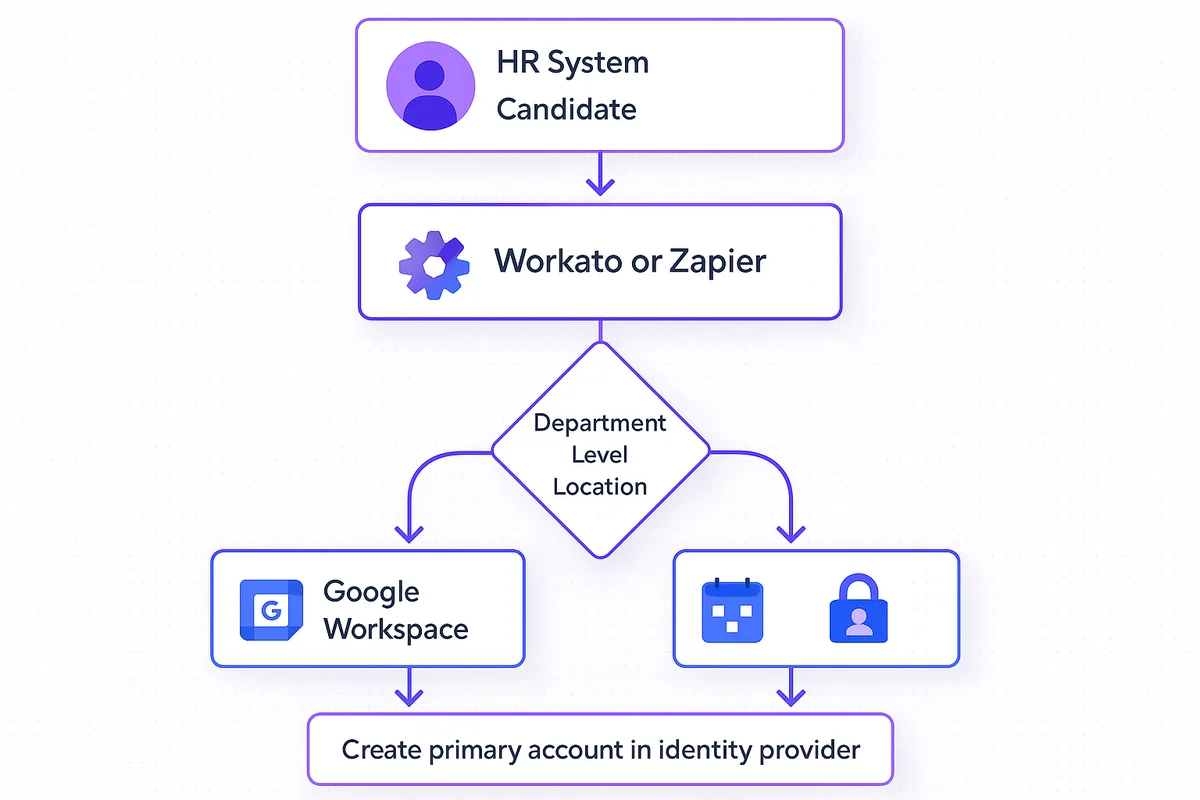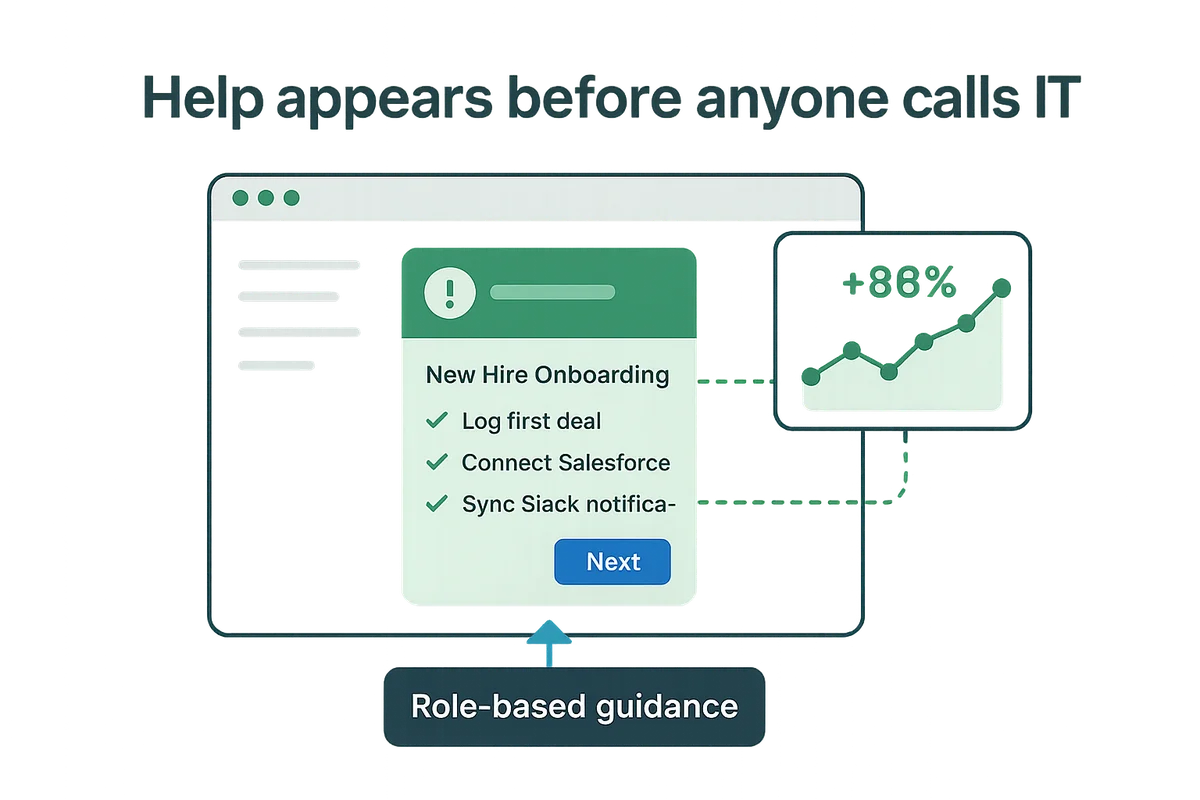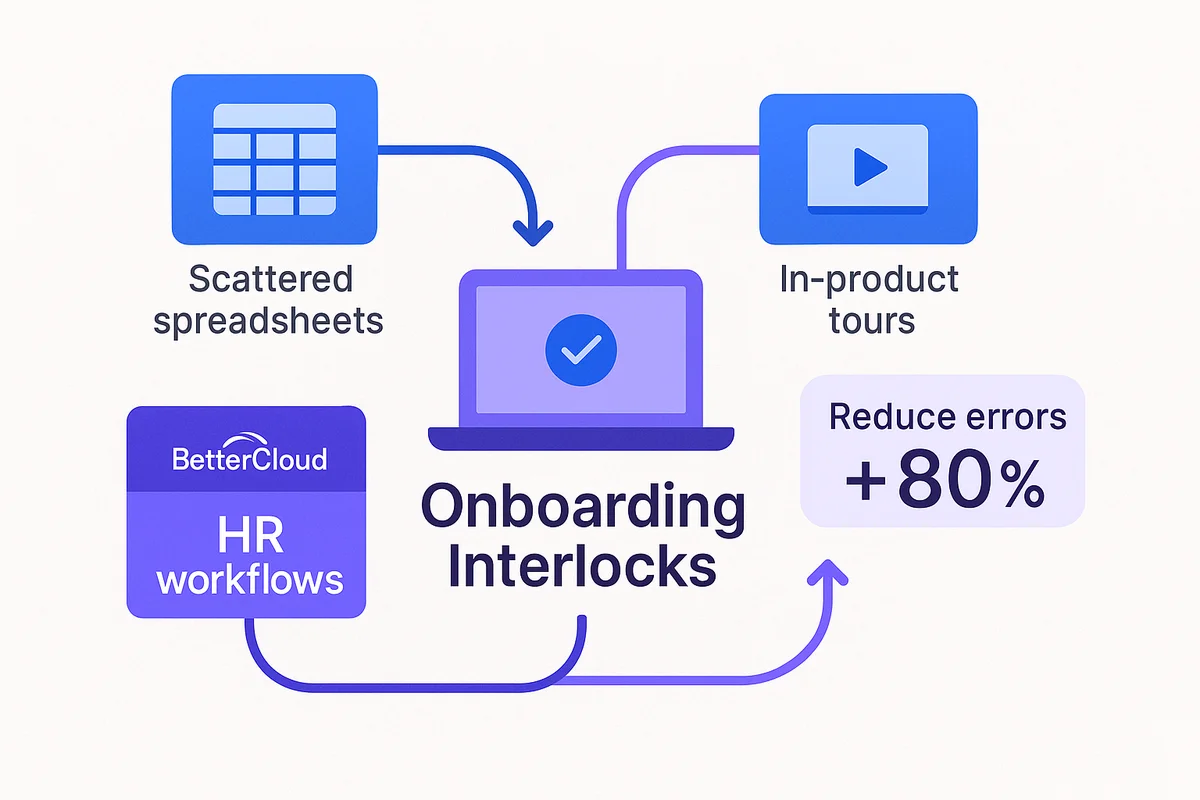3 Ways to Automate SaaS User Onboarding (Without Losing Control)

Most employee onboarding today runs through a tangle of cloud apps. When those systems don’t talk to each other, new hires wait, managers chase tickets, and IT burns hours on basics. Multiply that by dozens of hires a month and the cracks widen into visible cost.
Three proven automation layers can turn that mess into a reliable process. SaaS management platforms pull access control into one place, HRIS-triggered workflows pass data between systems, and in-app tours coach employees without constant help. Together they clear bottlenecks, lower risk, and give every team measurable results.
This guide shows how each layer operates and how the trio makes onboarding faster, safer, and scalable.
Table of Contents
- Centralize Provisioning with SaaS Management Platforms
- Let HRIS Events Drive iPaaS Workflows
- Product-Led Tours that Onboard Themselves
- Conclusion
- Audit your company's SaaS usage today
Centralize Provisioning with SaaS Management Platforms
Too many SaaS apps turn onboarding into a scavenger hunt for licenses and policies. When each team buys its own tools, IT bounces between admin panels while new hires wait for access. Platforms such as BetterCloud and Torii pull every cloud service into one command center so IT can see people, seats, and security rules in the same window.
These platforms sit on top of your HRIS or identity provider and watch for status changes like “pre-hire” or “terminated.” The moment HR flips a flag, the system spins up a role-based bundle: Zoom Pro for sales, Figma for design, nothing extra for contractors, then applies the right security policies before the employee even opens a laptop. When someone leaves, the same engine sweeps through every app, yanking tokens and reclaiming licenses in minutes rather than days.
- Fewer mis-licensed seats; Gartner notes that 30% of SaaS spend hides in unused or over-provisioned accounts.
- Onboarding hours returned to IT and HR instead of hunting down “who still needs Slack?”
- Clean audit trails that tie every click and policy change to a user, date, and reason.
- Employees who sign in on day one without “access denied” pop-ups.
Despite all this automation, IT still keeps the keys and overall authority. Admins can place approval gates on costly tools, set least-privilege defaults that match internal policies, and pull real-time logs for security without flooding the help desk. Because everything routes through one dashboard, prepping for ISO or SOC audits becomes a data export instead of a two-week scramble. Even so, the real win is calmer onboarding: no spreadsheets, no guesswork, just the right apps delivered at the right moment, every time.

Let HRIS Events Drive iPaaS Workflows
A single field change in the HR system kicks off the whole stack. When HR switches the “candidate” flag to “employee,” Workato or Zapier picks up the record, checks department, level, and location, then pushes the details to every downstream app on its own. The new hire never notices the orchestration while IT dodges the usual flood of day-one tickets.
In modern onboarding workflows, role-based templates inside the iPaaS handle the decisions. For a sales hire in London, the workflow creates a Google Workspace inbox, adds EMEA holidays, and formats the phone number with +44. A junior engineer in Austin gets a different bundle and separate security groups. Because each step is predefined, the process wipes out the copy-paste errors that show up when teams juggle checklists.
Here’s what a normal, well-automated first-day sequence for a new employee looks like:
- Create the primary account in the identity provider and enforce a strong password policy.
- Add the hire to the usual groups, then queue sensitive groups until the manager signs off.
- Send calendar invites for onboarding sessions and include links to the right Slack channels.
- Open an asset ticket so Facilities ships the laptop to the correct address.
- Drop a note in #new-hires when everything finishes, giving HR quick confirmation.
Even with automation humming in the background, IT still holds the keys. Multi-step approvals guard high-privilege apps; real-time alerts pop when a field is blank or a step fails. Centralized logs trace every action back to the original HR change, trimming audit prep from a week of sleuthing to a few filter clicks. Teams running well-tuned flows see real gains: up to 75 percent faster onboarding, 40 percent fewer access mistakes, and almost no “reset my password” calls on day one. With account chores off their plate, IT tackles bigger projects and HR greets new hires without the usual hiccups.

Product-Led Tours that Onboard Themselves
New hires open the app and see help pop up before anyone calls IT. By layering Appcues or Pendo on top of core tools, the tech team turns the product into the coach. Click-by-click walkthroughs, gated checklists, and smart tooltips point to the next step, trimming first-day confusion without another Zoom demo.
Persona-based rules keep each prompt on point for every new employee. A sales rep sees how to log the first deal, connect Salesforce, and sync Slack notifications. An engineer, logging in minutes later, meets API keys, staging URLs, and feature flag settings. That split relies on simple role metadata, so HR updates a field and the right flow shows up.
In most organizations, the capabilities that teams ask for look like this:
- Version history that lets trainers roll back a flawed step in seconds
- Feature gating so unfinished modules stay invisible to payroll clerks but open to beta testers
- Conditional logic that skips repetitive screens if the user already completed a task elsewhere
- Language packs that surface the same checklist in English, Spanish, or Japanese without cloning flows
Data coming back from these prompts matters as much as the guidance itself. Dashboards in WalkMe break down drop-off by step, letting admins compare two versions of the same tour with an A/B toggle. In practice, this data-driven approach lets teams promote the best-performing flow to every region within minutes, with no support tickets needed while Okta policies continue to enforce least privilege.
The real operational impact of onboarding software shows up in the metrics. Appcues reports customers cut how-to support tickets by 30 percent and hit activation milestones 70 percent faster. Multiply that across every app in the stack, and the hours freed up dwarf the time once spent building slide decks, scheduling trainers, and fielding “where is that button” chats. Product-led onboarding handles the click trail so people can get straight to work.

Conclusion
Onboarding often collapses when teams rely on scattered spreadsheets and informal hallway favors. Modern SaaS management hubs, HRIS workflows, and concise in-app guidance now interlock so every hire receives the right tools at the right moment. IT can review logs, finance can track license counts, and employees always know their next step.
When BetterCloud connects HR triggers to in-product tours, support teams stop chasing tickets and focus on outcomes. Shared SaaS controls, automated HR workflows, and guided tours reduce errors, accelerate onboarding, and keep IT firmly in charge.

Audit your company’s SaaS usage today
If you’re interested in learning more about SaaS Management, let us know. Torii’s SaaS Management Platform can help you:
- Find hidden apps: Use AI to scan your entire company for unauthorized apps. Happens in real-time and is constantly running in the background.
- Cut costs: Save money by removing unused licenses and duplicate tools.
- Implement IT automation: Automate your IT tasks to save time and reduce errors - like offboarding and onboarding automation.
- Get contract renewal alerts: Ensure you don’t miss important contract renewals.
Torii is the industry’s first all-in-one SaaS Management Platform, providing a single source of truth across Finance, IT, and Security.
You can learn more about Torii here.
Frequently Asked Questions
SaaS management platforms centralize access control, streamline software provisioning, and ensure new hires receive necessary apps immediately, reducing wait times and errors during onboarding.
HRIS events trigger automated workflows that manage employee status changes, delivering essential tools and access without burdening IT or HR teams with manual tasks.
In-app tours provide step-by-step guidance tailored to user roles, helping new hires navigate tools and processes quickly, thus reducing confusion and support requests.
Automation layers minimize manual tasks for IT, streamline access management, and improve efficiency, allowing teams to focus on strategic initiatives instead of onboarding logistics.
Centralized software control reduces over-provisioned accounts, enhances security through consistent policies, and simplifies auditing, all contributing to a more streamlined onboarding process.
Automated workflows can accelerate onboarding by up to 75%, reducing errors and minimizing the need for IT assistance, allowing new hires to become productive faster.
Tracking data during onboarding helps identify bottlenecks, improve processes, and enhance user guidance, ultimately leading to a more effective onboarding experience for new employees.

